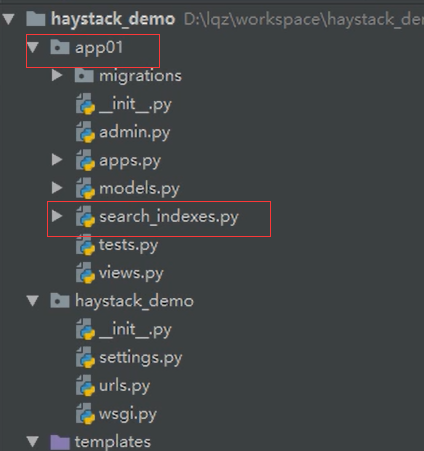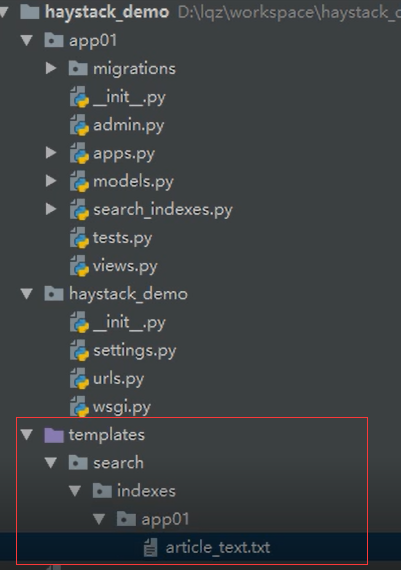Haystack
一 Haystack简介
1.什么是Haystack
Haystack是django的开源全文搜索框架(全文检索不同于特定字段的模糊查询,使用全文检索的效率更高 ),该框架支持Solr,Elasticsearch,Whoosh, **Xapian
-
全文检索不同于特定字段的模糊查询,使用全文检索的效率更高,并且能够对于中文进行分词处理
-
haystack:django的一个包,可以方便地对model里面的内容进行索引、搜索,设计为支持whoosh,solr,Xapian,Elasticsearc四种全文检索引擎后端,属于一种全文检索的框架
-
whoosh:纯Python编写的全文搜索引擎,虽然性能比不上sphinx、xapian、Elasticsearc等,但是无二进制包,程序不会莫名其妙的崩溃,对于小型的站点,whoosh已经足够使用
-
jieba:一款免费的中文分词包,如果觉得不好用可以使用一些收费产品
二 Haystack使用
#安装框架 pip3 install django-haystack #安装引擎 pip3 install whoosh #安装中文分词工具 pip3 install jieba
添加Haystack到INSTALLED_APPS
跟大多数Django的应用一样,你应该在你的设置文件(通常是settings.py)添加Haystack到INSTALLED_APPS. 示例:

INSTALLED_APPS = [ 'django.contrib.admin', 'django.contrib.auth', 'django.contrib.contenttypes', 'django.contrib.sessions', 'django.contrib.sites', # 添加 'haystack', # 你的app 'blog', ]
2.2引擎配置
修改settings.py
在你的settings.py中,你需要添加一个设置来指示站点配置文件正在使用的后端,以及其它的后端设置。 HAYSTACK——CONNECTIONS是必需的设置,并且应该至少是以下的一种:

HAYSTACK_CONNECTIONS = { 'default': { 'ENGINE': 'haystack.backends.solr_backend.SolrEngine', 'URL': 'http://127.0.0.1:8983/solr' # ...or for multicore... # 'URL': 'http://127.0.0.1:8983/solr/mysite', }, }

HAYSTACK_CONNECTIONS = { 'default': { 'ENGINE': 'haystack.backends.elasticsearch_backend.ElasticsearchSearchEngine', 'URL': 'http://127.0.0.1:9200/', 'INDEX_NAME': 'haystack', }, }

#需要设置PATH到你的Whoosh索引的文件系统位置 import os HAYSTACK_CONNECTIONS = { 'default': { 'ENGINE': 'haystack.backends.whoosh_backend.WhooshEngine', 'PATH': os.path.join(os.path.dirname(__file__), 'whoosh_index'), }, } # 自动更新索引 HAYSTACK_SIGNAL_PROCESSOR = 'haystack.signals.RealtimeSignalProcessor'

#首先安装Xapian后端(http://github.com/notanumber/xapian-haystack/tree/master) #需要设置PATH到你的Xapian索引的文件系统位置。 import os HAYSTACK_CONNECTIONS = { 'default': { 'ENGINE': 'xapian_backend.XapianEngine', 'PATH': os.path.join(os.path.dirname(__file__), 'xapian_index'), }, }
3.创建索引和数据模板
3.2创建索引代码:search_indexes.py文件

from haystack import indexes #导入要检索的model类 from app01.models import Article #类名必须为需要检索的Model_name+Index,这里需要检索Article,所以创建ArticleIndex class ArticleIndex(indexes.SearchIndex, indexes.Indexable): text = indexes.CharField(document=True, use_template=True)#固定写法:创建一个text字段 #其它字段可有可无 desc = indexes.CharField(model_attr='desc') content = indexes.CharField(model_attr='content') def get_model(self):#重载get_model方法,必须要有! return Article def index_queryset(self, using=None): return self.get_model().objects.all() """ 为什么要创建索引?索引就像是一本书的目录,可以为读者提供更快速的导航与查找。在这里也是同样的道理,当数据量非常大的时候,若要从这些数据里找出所有的满足搜索条件的几乎是不太可能的,将会给服务器带来极大的负担。所以我们需要为指定的数据添加一个索引(目录),在这里是为Note创建一个索引,索引的实现细节是我们不需要关心的,至于为它的哪些字段创建索引,怎么指定 ,下面开始讲解 每个索引里面必须有且只能有一个字段为 document=True,这代表haystack 和搜索引擎将使用此字段的内容作为索引进行检索(primary field)。其他的字段只是附属的属性,方便调用,并不作为检索数据 注意:如果使用一个字段设置了document=True,则一般约定此字段名为text,这是在ArticleIndex类里面一贯的命名,以防止后台混乱,当然名字你也可以随便改,不过不建议改。 """
3.3创建数据模板
#2.模板数据py文件编写
#在目录“templates/search/indexes/应用名称/”下创建“模型类名称_text.txt”文件 #固定写法{{ object.models字段名}},一个或多个 {{ object.title }} {{ object.desc }} {{ object.content }} #这个数据模板的作用是对`Note.title`, `Note.user.get_full_name`,`Note.body`这三个字段建立索引,当检索的时候会对这三个字段做全文检索匹配
添加SearchView到你的URLconf
在你的URLconf
(r'^search/', include('haystack.urls')),


<!DOCTYPE html> <html> <head> <title></title> <style> span.highlighted { color: red; } </style> </head> <body> {% load highlight %} {% if query %} <h3>搜索结果如下:</h3> {% for result in page.object_list %} {# <a href="/{{ result.object.id }}/">{{ result.object.title }}</a><br/>#} <a href="/{{ result.object.id }}/">{% highlight result.object.title with query max_length 2%}</a><br/> <p>{{ result.object.content|safe }}</p> <p>{% highlight result.content with query %}</p> {% empty %} <p>啥也没找到</p> {% endfor %} {% if page.has_previous or page.has_next %} <div> {% if page.has_previous %} <a href="?q={{ query }}&page={{ page.previous_page_number }}">{% endif %}« 上一页 {% if page.has_previous %}</a>{% endif %} | {% if page.has_next %}<a href="?q={{ query }}&page={{ page.next_page_number }}">{% endif %}下一页 » {% if page.has_next %}</a>{% endif %} </div> {% endif %} {% endif %} </body> </html>
现在你已经配置好了所有的事情,是时候把数据库中的数据放入索引了。Haystack附带的一个命令行管理工具使它变得很容易。
简单的运行 ./manage.py rebuild_index。你会得到有多少模型进行了处理并放进索引的统计。
建立
7.1在haystack的安装文件夹下(路径如“D:\python3\Lib\site-packages\haystack\backends”),建立ChineseAnalyzer.py文件,并编写以下代码


import jieba from whoosh.analysis import Tokenizer, Token class ChineseTokenizer(Tokenizer): def __call__(self, value, positions=False, chars=False, keeporiginal=False, removestops=True, start_pos=0, start_char=0, mode='', **kwargs): t = Token(positions, chars, removestops=removestops, mode=mode, **kwargs) seglist = jieba.cut(value, cut_all=True) for w in seglist: t.original = t.text = w t.boost = 1.0 if positions: t.pos = start_pos + value.find(w) if chars: t.startchar = start_char + value.find(w) t.endchar = start_char + value.find(w) + len(w) yield t def ChineseAnalyzer(): return ChineseTokenizer()
7.2
#复制whoosh_backend.py文件,改名为whoosh_cn_backend.py #注意:导入下面模块末尾会有一个空格,记得要删除这个空格 from .ChineseAnalyzer import ChineseAnalyzer 查找 analyzer=StemmingAnalyzer() 改为 analyzer=ChineseAnalyzer()
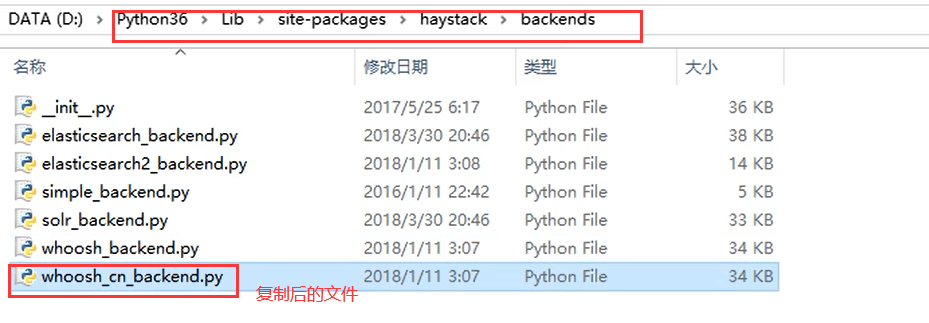


<form method='get' action="/search/" target="_blank"> <input type="text" name="q"> <input type="submit" value="查询"> </form>
前后端分离时
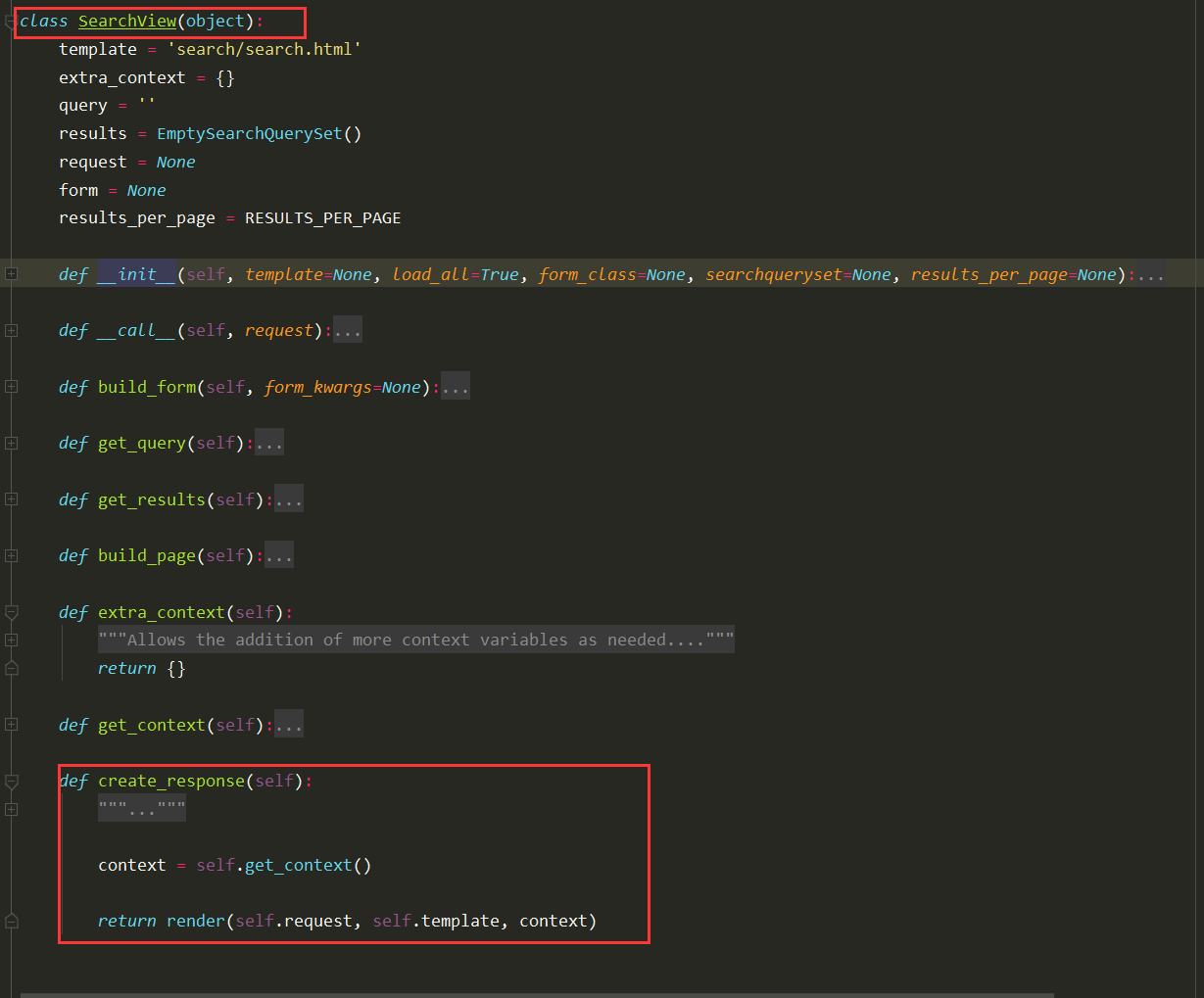

from haystack.views import SearchView from django.http import JsonResponse class MysearchView(SearchView): def create_response(self): """ Generates the actual HttpResponse to send back to the user. """ context = self.get_context() data_list=[] data_dict={} for i in context['page'].object_list: data_dict['id']=i.object.id data_dict['name']=i.object.name data_dict['content'] = i.object.content data_list.append(data_dict) # print(context['page'].object_list) # return JsonResponse(data_list,safe=False,json_dumps_params={'ensure_ascii':False}) url url(r'^search/', search.MysearchView()),
8.其它配置

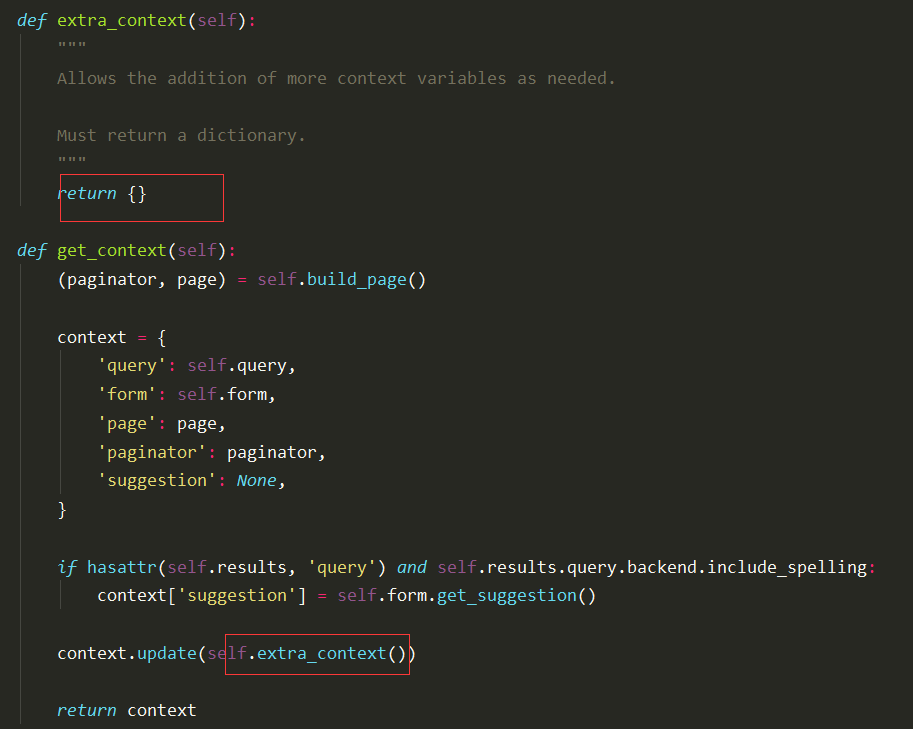
增加更多变量

from haystack.views import SearchView from .models import * class MySeachView(SearchView): def extra_context(self): #重载extra_context来添加额外的context内容 context = super(MySeachView,self).extra_context() side_list = Topic.objects.filter(kind='major').order_by('add_date')[:8] context['side_list'] = side_list return context #路由修改 url(r'^search/', search_views.MySeachView(), name='haystack_search'),

{% highlight result.summary with query %}
# 这里可以限制最终{{ result.summary }}被高亮处理后的长度
{% highlight result.summary with query max_length 40 %}
#html中
<style>
span.highlighted {
color: red;
}
</style>




